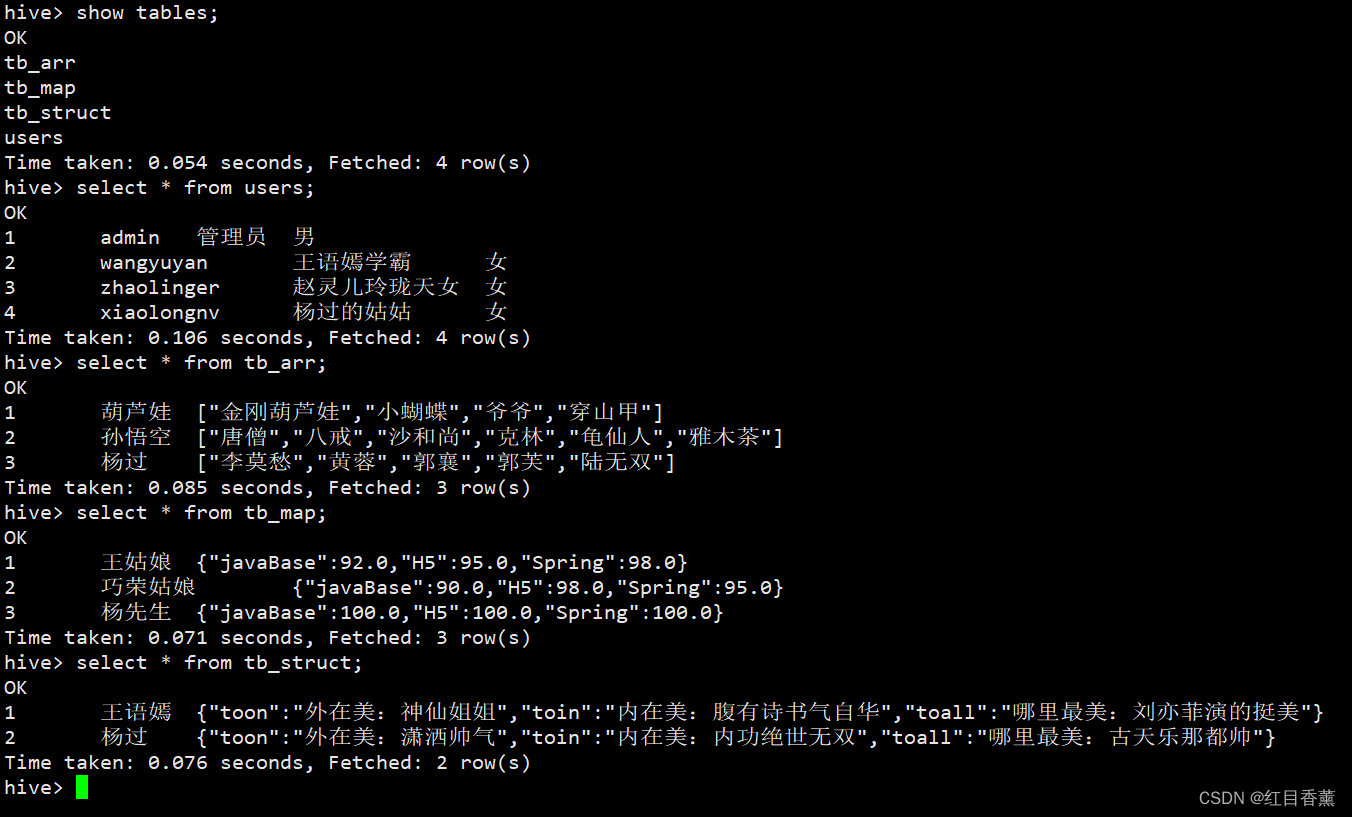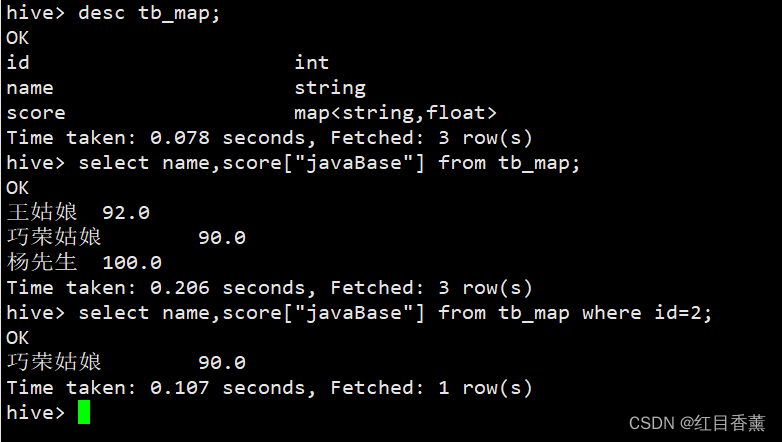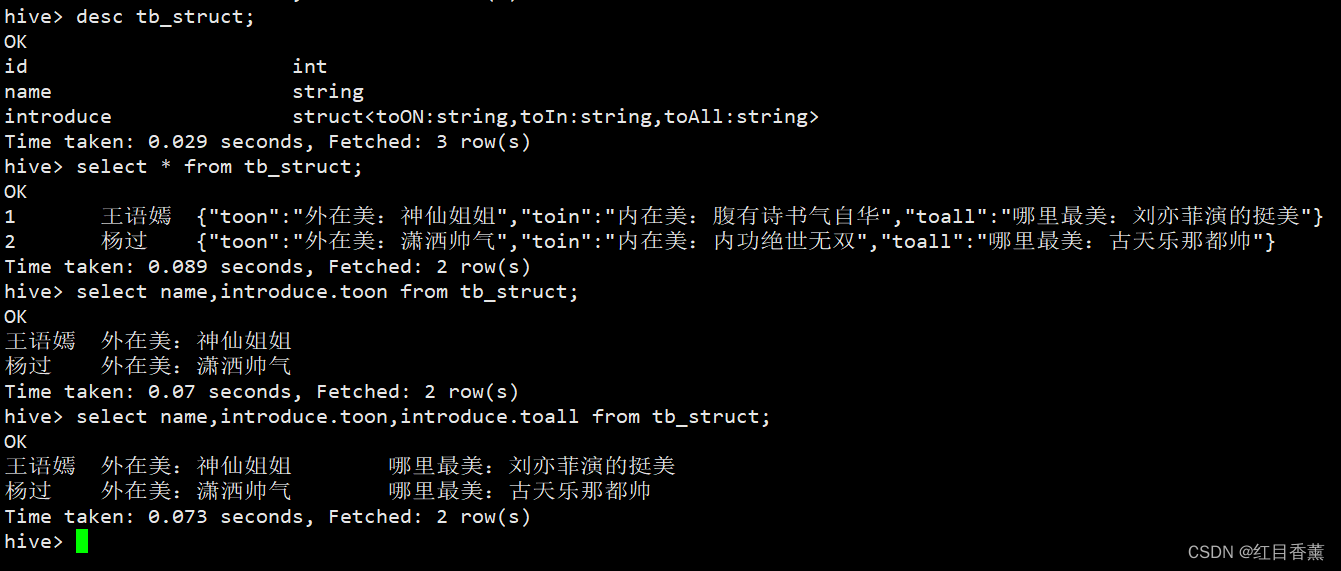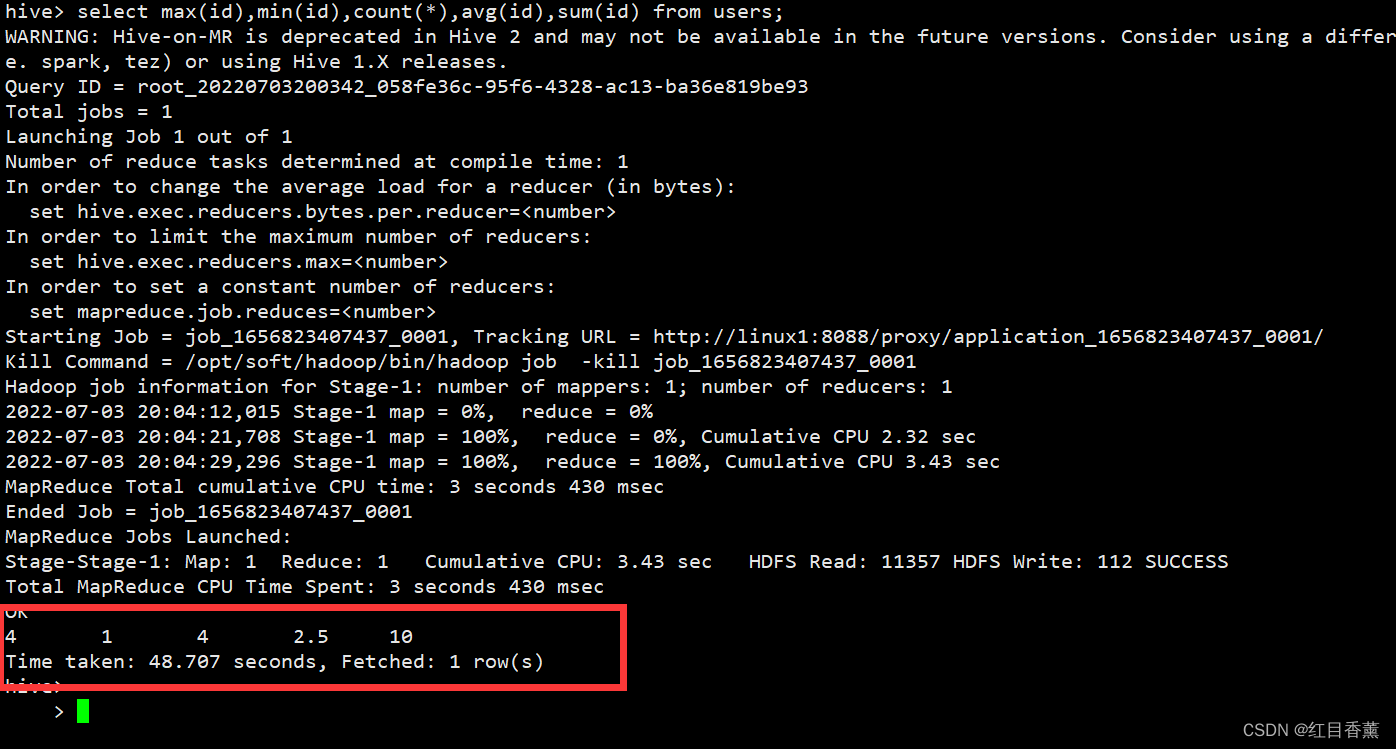Hive基础09、HQL查询语句
Hive基础09、HQL查询语句
目录
hive当中的lateral view 与 explode以及reflect
使用explode函数将hive表中的Map和Array字段数据进行拆分
1、基础查询语句
那么,可以根据它来查询任何表,都会显示数据的。
2、数组查询
通过下标的方式处理数据
where筛选
like模糊查询
between……and……
3、map
语法就是【列名】["keyName"]就可以获取值了。
结构查询
map查询
where查询
4、struct
struct获取信息需要使用【.】来处理,以下是示例:
5、聚合查询语句
max/min/count/avg/sum
HQL查询内容全:
第一部分:
- hive模糊搜索表:
show tables like '*name*'; - 查看表结构信息:
desc table_name; - 查看分区信息:
show partitions table_name; - 加载本地文件:
load data local inpath '/xxx/test.txt' overwrite into table dm.table_name; - 从查询语句给table插入数据:
insert overwrite table table_name partition(dt) select * from table_name; - 导出数据到本地系统:
insert overwrite local directory '/tmp/text' select a.* from table_name a order by 1; - 创建表时指定的一些属性:
- 字段分隔符:
row format delimited fields terminated by '\t' - 行分隔符:
row format delimited lines terminated by '\n' - 文件格式为文本型存储:
stored as textfile
- 命令行操作:
hive -e 'select table_cloum from table'执行一个查询,在终端上显示mapreduce的进度,执行完毕后,最后把查询结果输出到终端上,接着hive进程退出,不会进入交互模式
hive -S -e 'select table_cloum from table' -S,终端上的输出不会有mapreduce的进度,执行完毕,只会把查询结果输出到终端上。
- hive修改表名:
alter table old_table_name rename to new_table_name; - hive复制表结构:
create table new_table_name like table_name; - hive添加字段:
alter table table_name add columns(columns_values bigint comment 'comm_text'); - hive修改字段:
alter table table_name change old_column new_column string comment 'comm_text'; - 删除分区:
alter table table_name drop partition(dt='2021-11-30'); - 添加分区:
alter table table_name add partition (dt='2021-11-30'); - 删除空数据库:
drop database myhive2; - 强制删除数据库:
drop database myhive2 cascade; - 删除表:
drop table score5; - 清空表:
truncate table score6; - 向hive表中加载数据
- 直接向分区表中插入数据:
insert into table score partition(month ='202107') values ('001','002','100'); - 通过load方式加载数据:
load data local inpath '/export/servers/hivedatas/score.csv' overwrite into table score partition(month='201806'); - 通过查询方式加载数据:
insert overwrite table score2 partition(month = '202106') select s_id,c_id,s_score from score1; - 查询语句中创建表并加载数据:
create table score2 as select * from score1; - 在创建表是通过location指定加载数据的路径:
create external table score6 (s_id string,c_id string,s_score int) row format delimited fields terminated by ',' location '/myscore'; - export导出与import 导入 hive表数据(内部表操作):
create table techer2 like techer; --依据已有表结构创建表
export table techer to '/export/techer';
import table techer2 from '/export/techer';
20. hive表中数据导出
- insert导出
将查询的结果导出到本地: insert overwrite local directory '/export/servers/exporthive' select * from score;
将查询的结果格式化导出到本地:insert overwrite local directory '/export/servers/exporthive' row format delimited fields terminated by '\t' collection items terminated by '#' select * from student;
将查询的结果导出到HDFS上(没有local):insert overwrite directory '/export/servers/exporthive' row format delimited fields terminated by '\t' collection items terminated by '#' select * from score;
- Hadoop命令导出到本地:
dfs -get /export/servers/exporthive/000000_0 /export/servers/exporthive/local.txt; - hive shell 命令导出
基本语法:(hive -f/-e 执行语句或者脚本 > file) hive -e "select * from myhive.score;" > /export/servers/exporthive/score.txt
hive -f export.sh > /export/servers/exporthive/score.txt
- export导出到HDFS上:
export table score to '/export/exporthive/score';
Hive查询语句
- GROUP BY 分组:
select s_id ,avg(s_score) avgscore from score group by s_id having avgscore > 85;对分组后的数据进行筛选,使用 having - join 连接:inner join 内连接;left join 左连接;right join 右链接;full join 全外链接。
- order by 排序:ASC(ascend): 升序(默认) DESC(descend): 降序
- sort by 局部排序:每个MapReduce内部进行排序,对全局结果集来说不是排序。
- distribute by 分区排序:类似MR中partition,进行分区,结合sort by使用
Hive函数
1. 聚合函数
- 指定列值的数目:count()
- 指定列值求和:sum()
- 指定列的最大值:max()
- 指定列的最小值:min()
- 指定列的平均值:avg()
- 非空集合总体变量函数:var_pop(col)
- 非空集合样本变量函数:var_samp (col)
- 总体标准偏离函数:stddev_pop(col)
- 分位数函数:percentile(BIGINT col, p)
- 中位数函数:percentile(BIGINT col, 0.5)
2. 关系运算
- A LIKE B: LIKE比较,如果字符串A符合表达式B 的正则语法,则为TRUE
- A RLIKE B:JAVA的LIKE操作,如果字符串A符合JAVA正则表达式B的正则语法,则为TRUE
- A REGEXP B:功能与RLIKE相同
3. 数学运算
支持所有数值类型:加(+)、减(-)、乘(*)、除(/)、取余(%)、位与(&)、位或(|)、位异或(^)、位取反(~)
4. 逻辑运算
支持:逻辑与(and)、逻辑或(or)、逻辑非(not)
5. 数值运算
- 取整函数:round(double a)
- 指定精度取整函数:round(double a, int d)
- 向下取整函数:floor(double a)
- 向上取整函数:ceil(double a)
- 取随机数函数:rand(),rand(int seed)
- 自然指数函数:exp(double a)
- 以10为底对数函数:log10(double a)
- 以2为底对数函数:log2()
- 对数函数:log()
- 幂运算函数:pow(double a, double p)
- 开平方函数:sqrt(double a)
- 二进制函数:bin(BIGINT a)
- 十六进制函数:hex()
- 绝对值函数:abs()
- 正取余函数:pmod()
6. 条件函数
- if
- case when
- coalesce(c1,c2,c3)
- nvl(c1,c2)
7. 日期函数
- 获得当前时区的UNIX时间戳: unix_timestamp()
- 时间戳转日期函数:from_unixtime()
- 日期转时间戳:unix_timestamp(string date)
- 日期时间转日期函数:to_date(string timestamp)
- 日期转年函数:year(string date)
- 日期转月函数:month (string date)
- 日期转天函数: day (string date)
- 日期转小时函数: hour (string date)
- 日期转分钟函数:minute (string date)
- 日期转秒函数: second (string date)
- 日期转周函数: weekofyear (string date)
- 日期比较函数: datediff(string enddate, string startdate)
- 日期增加函数: date_add(string startdate, int days)
- 日期减少函数:date_sub (string startdate, int days)
8. 字符串函数
- 字符串长度函数:length(string A)
- 字符串反转函数:reverse(string A)
- 字符串连接函数: concat(string A, string B…)
- 带分隔符字符串连接函数:concat_ws(string SEP, string A, string B…)
- 字符串截取函数: substr(string A, int start, int len)
- 字符串转大写函数: upper(string A)
- 字符串转小写函数:lower(string A)
- 去空格函数:trim(string A)
- 左边去空格函数:ltrim(string A)
- 右边去空格函数:rtrim(string A)
- 正则表达式替换函数: regexp_replace(string A, string B, string C)
- 正则表达式解析函数: regexp_extract(string subject, string pattern, int index)
- URL解析函数:parse_url(string urlString, string partToExtract [, string keyToExtract]) 返回值: string
- json解析函数:get_json_object(string json_string, string path)
- 空格字符串函数:space(int n)
- 重复字符串函数:repeat(string str, int n)
- 首字符ascii函数:ascii(string str)
- 左补足函数:lpad(string str, int len, string pad)
- 右补足函数:rpad(string str, int len, string pad)
- 分割字符串函数: split(string str, string pat)
- 集合查找函数: find_in_set(string str, string strList)
9. 窗口函数
- 分组求和函数:
sum(pv) over(partition by cookieid order by createtime)有坑,加不加 order by 差别很大,具体详情在下面第二部分。 - 分组内排序,从1开始顺序排:ROW_NUMBER() 如:1234567
- 分组内排序,排名相等会在名次中留下空位:RANK() 如:1233567
- 分组内排序,排名相等不会在名次中留下空位:DENSE_RANK() 如:1233456
- 有序的数据集合平均分配到指定的数量(num)个桶中:NTILE()
- 统计窗口内往上第n行值:LAG(col,n,DEFAULT)
- 统计窗口内往下第n行值:LEAD(col,n,DEFAULT)
- 分组内排序后,截止到当前行,第一个值:FIRST_VALUE(col)
- 分组内排序后,截止到当前行,最后一个值: LAST_VALUE(col)
- 小于等于当前值的行数/分组内总行数:CUME_DIST()
以下函数建议看第二部分详细理解下,此处仅简写,!
- 将多个group by 逻辑写在一个sql语句中: GROUPING SETS
- 根据GROUP BY的维度的所有组合进行聚合:CUBE
- CUBE的子集,以最左侧的维度为主,从该维度进行层级聚合:ROLLUP
第二部分
1. 对数据库的操作
- 创建数据库:
- 修改数据库:
说明:可以使用alter database 命令来修改数据库的一些属性。但是数据库的元数据信息是不可更改的,包括数据库的名称以及数据库所在的位置
- 查看数据库详细信息
- 删除数据库
2. 对数据表的操作
对管理表(内部表)的操作:
- 建内部表:
- hive建表时候的字段类型:
| 分类 | 类型 | 描述 | 字面量示例 |
|---|
对decimal类型简单解释下:
用法:decimal(11,2) 代表最多有11位数字,其中后2位是小数,整数部分是9位;如果整数部分超过9位,则这个字段就会变成null;如果小数部分不足2位,则后面用0补齐两位,如果小数部分超过两位,则超出部分四舍五入
也可直接写 decimal,后面不指定位数,默认是 decimal(10,0) 整数10位,没有小数
- 创建表并指定字段之间的分隔符
row format delimited fields terminated by '\t' 指定字段分隔符,默认分隔符为 '\001'
stored as 指定存储格式
location 指定存储位置
- 根据查询结果创建表
- 根据已经存在的表结构创建表
- 查询表的结构
- 查询创建表的语句
对外部表操作
外部表因为是指定其他的hdfs路径的数据加载到表当中来,所以hive表会认为自己不完全独占这份数据,所以删除hive表的时候,数据仍然存放在hdfs当中,不会删掉,只会删除表的元数据
- 构建外部表
- 从本地文件系统向表中加载数据
- 从hdfs文件系统向表中加载数据
- 注意:
1.使用 load data local 表示从本地文件系统加载,文件会拷贝到hdfs上
2.使用 load data 表示从hdfs文件系统加载,文件会直接移动到hive相关目录下,注意不是拷贝过去,因为hive认为hdfs文件已经有3副本了,没必要再次拷贝了
3.如果表是分区表,load 时不指定分区会报错
4.如果加载相同文件名的文件,会被自动重命名
对分区表的操作
- 创建分区表的语法
- 创建一个表带多个分区
注意:
hive表创建的时候可以用 location 指定一个文件或者文件夹,当指定文件夹时,hive会加载文件夹下的所有文件,当表中无分区时,这个文件夹下不能再有文件夹,否则报错
当表是分区表时,比如 partitioned by (day string), 则这个文件夹下的每一个文件夹就是一个分区,且文件夹名为 day=20201123 这种格式,然后使用:msck repair table score; 修复表结构,成功之后即可看到数据已经全部加载到表当中去了
- 加载数据到一个分区的表中
- 加载数据到一个多分区的表中去
- 查看分区
- 添加一个分区
- 同时添加多个分区
注意:添加分区之后就可以在hdfs文件系统当中看到表下面多了一个文件夹
- 删除分区
对分桶表操作
将数据按照指定的字段进行分成多个桶中去,就是按照分桶字段进行哈希划分到多个文件当中去
分区就是分文件夹,分桶就是分文件
分桶优点:
1. 提高join查询效率
2. 提高抽样效率
- 开启hive的捅表功能
- 设置reduce的个数
- 创建桶表
桶表的数据加载:由于桶表的数据加载通过hdfs dfs -put文件或者通过load data均不可以,只能通过insert overwrite 进行加载
所以把文件加载到桶表中,需要先创建普通表,并通过insert overwrite的方式将普通表的数据通过查询的方式加载到桶表当中去
- 通过insert overwrite给桶表中加载数据
修改表和删除表
- 修改表名称
- 增加/修改列信息
- 删除表操作
- 清空表操作
注意:truncate 和 drop:
如果 hdfs 开启了回收站,drop 删除的表数据是可以从回收站恢复的,表结构恢复不了,需要自己重新创建;truncate 清空的表是不进回收站的,所以无法恢复truncate清空的表
所以 truncate 一定慎用,一旦清空将无力回天
向hive表中加载数据
- 直接向分区表中插入数据
- 通过load方式加载数据
- 通过查询方式加载数据
- 查询语句中创建表并加载数据
- 在创建表是通过location指定加载数据的路径
- export导出与import 导入 hive表数据(内部表操作)
hive表中数据导出
- insert导出
- Hadoop命令导出到本地
- hive shell 命令导出
- export导出到HDFS上
hive的DQL查询语法
单表查询
注意:
1、order by 会对输入做全局排序,因此只有一个reducer,会导致当输入规模较大时,需要较长的计算时间。
2、sort by不是全局排序,其在数据进入reducer前完成排序。因此,如果用sort by进行排序,并且设置mapred.reduce.tasks>1,则sort by只保证每个reducer的输出有序,不保证全局有序。
3、distribute by(字段)根据指定的字段将数据分到不同的reducer,且分发算法是hash散列。
4、Cluster by(字段) 除了具有Distribute by的功能外,还会对该字段进行排序。
因此,如果分桶和sort字段是同一个时,此时,cluster by = distribute by + sort by
- WHERE语句
注意:
小于某个值是不包含null的,如上查询结果是把 s_score 为 null 的行剔除的
- GROUP BY 分组
注意:
如果使用 group by 分组,则 select 后面只能写分组的字段或者聚合函数
where和having区别:
1 having是在 group by 分完组之后再对数据进行筛选,所以having 要筛选的字段只能是分组字段或者聚合函数
2 where 是从数据表中的字段直接进行的筛选的,所以不能跟在gruop by后面,也不能使用聚合函数
- join 连接
注:1. hive2版本已经支持不等值连接,就是 join on条件后面可以使用大于小于符号了;并且也支持 join on 条件后跟or (早前版本 on 后只支持 = 和 and,不支持 > < 和 or)
2.如hive执行引擎使用MapReduce,一个join就会启动一个job,一条sql语句中如有多个join,则会启动多个job
注意:表之间用逗号(,)连接和 inner join 是一样的
select * from table_a,table_b where table_a.id=table_b.id;
它们的执行效率没有区别,只是书写方式不同,用逗号是sql 89标准,join 是sql 92标准。用逗号连接后面过滤条件用 where ,用 join 连接后面过滤条件是 on。
- order by 排序
注意:order by 是全局排序,所以最后只有一个reduce,也就是在一个节点执行,如果数据量太大,就会耗费较长时间
- sort by 局部排序
- distribute by 分区排序
注意:Hive要求 distribute by 语句要写在 sort by 语句之前
- cluster by
Hive函数
聚合函数
注意:
聚合操作时要注意null值
count(*) 包含null值,统计所有行数
count(id) 不包含null值
min 求最小值是不包含null,除非所有值都是null
avg 求平均值也是不包含null
- 非空集合总体变量函数: var_pop
- 非空集合样本变量函数: var_samp
- 总体标准偏离函数: stddev_pop
- 中位数函数: percentile
关系运算
- LIKE比较: LIKE
- JAVA的LIKE操作: RLIKE
- REGEXP操作: REGEXP
数学运算
逻辑运算
数值运算
- 取整函数: round
- 指定精度取整函数: round
- 向下取整函数: floor
- 向上取整函数: ceil
- 取随机数函数: rand
- 自然指数函数: exp
- 以10为底对数函数: log10
此外还有:以2为底对数函数: log2()、对数函数: log()
- 幂运算函数: pow
- 开平方函数: sqrt
- 二进制函数: bin
十六进制函数: hex()、将十六进制转化为字符串函数: unhex()
进制转换函数: conv(bigint num, int from_base, int to_base) 说明: 将数值num从from_base进制转化到to_base进制
此外还有很多数学函数: 绝对值函数: abs()、正取余函数: pmod()、正弦函数: sin()、反正弦函数: asin()、余弦函数: cos()、反余弦函数: acos()、positive函数: positive()、negative函数: negative()
条件函数
- If函数: if
- 非空查找函数: coalesce
- 条件判断函数:case when (两种写法,其一)
- 条件判断函数:case when (两种写法,其二)
日期函数
注:以下SQL语句中的 from tableName 可去掉,不影响查询结果
- 获取当前UNIX时间戳函数: unix_timestamp
- UNIX时间戳转日期函数: from_unixtime
- 日期转UNIX时间戳函数: unix_timestamp
- 指定格式日期转UNIX时间戳函数: unix_timestamp
- 日期时间转日期函数: to_date
- 日期转年函数: year
- 日期转月函数: month
- 日期转天函数: day
- 日期转小时函数: hour
- 日期转分钟函数: minute
- 日期转秒函数: second
- 日期转周函数: weekofyear
- 日期比较函数: datediff
- 日期增加函数: date_add
- 日期减少函数: date_sub
字符串函数
- 字符串长度函数:length
- 字符串反转函数:reverse
- 字符串连接函数:concat
- 带分隔符字符串连接函数:concat_ws
- 字符串截取函数:substr,substring
- 字符串截取函数:substr,substring
- 字符串转大写函数:upper,ucase
- 字符串转小写函数:lower,lcase
- 去空格函数:trim
- 左边去空格函数:ltrim
- 右边去空格函数:rtrim
- 正则表达式替换函数:regexp_replace
- 正则表达式解析函数:regexp_extract
- URL解析函数:parse_url
- json解析函数:get_json_object
- 空格字符串函数:space
- 重复字符串函数:repeat
- 首字符ascii函数:ascii
- 左补足函数:lpad
- 右补足函数:rpad
- 分割字符串函数: split
- 集合查找函数: find_in_set
复合类型构建操作
- Map类型构建: map
- Struct类型构建: struct
- array类型构建: array
复杂类型访问操作
- array类型访问: A[n]
- map类型访问: M[key]
- struct类型访问: S.x
复杂类型长度统计函数
- Map类型长度函数: size(Map<k .V>)
- array类型长度函数: size(Array)
- 类型转换函数 ***
hive当中的lateral view 与 explode以及reflect
使用explode函数将hive表中的Map和Array字段数据进行拆分
lateral view用于和split、explode等UDTF一起使用的,能将一行数据拆分成多行数据,在此基础上可以对拆分的数据进行聚合,lateral view首先为原始表的每行调用UDTF,UDTF会把一行拆分成一行或者多行,lateral view在把结果组合,产生一个支持别名表的虚拟表。
其中explode还可以用于将hive一列中复杂的array或者map结构拆分成多行
需求:现在有数据格式如下
字段之间使用\t分割,需求将所有的child进行拆开成为一列
将map的key和value也进行拆开,成为如下结果
- 创建hive数据库
- 创建hive表,然后使用explode拆分map和array
- 加载数据
- 使用explode将hive当中数据拆开
使用explode拆分json字符串
需求: 需求:现在有一些数据格式如下:
其中字段与字段之间的分隔符是 |
我们要解析得到所有的monthSales对应的值为以下这一列(行转列)
4900
2090
6987
- 创建hive表
- 准备数据并加载数据
- 使用explode拆分Array
- 使用explode拆解Map
- 拆解json字段
配合LATERAL VIEW使用
配合lateral view查询多个字段
也可以多重使用
最终,我们可以通过下面的句子,把这个json格式的一行数据,完全转换成二维表的方式展现
总结:
Lateral View通常和UDTF一起出现,为了解决UDTF不允许在select字段的问题。 Multiple Lateral View可以实现类似笛卡尔乘积。 Outer关键字可以把不输出的UDTF的空结果,输出成NULL,防止丢失数据。
行转列
相关参数说明:
CONCAT(string A/col, string B/col…):返回输入字符串连接后的结果,支持任意个输入字符串;
CONCAT_WS(separator, str1, str2,...):它是一个特殊形式的 CONCAT()。第一个参数剩余参数间的分隔符。分隔符可以是与剩余参数一样的字符串。如果分隔符是 NULL,返回值也将为 NULL。这个函数会跳过分隔符参数后的任何 NULL 和空字符串。分隔符将被加到被连接的字符串之间;
COLLECT_SET(col):函数只接受基本数据类型,它的主要作用是将某字段的值进行去重汇总,产生array类型字段。
数据准备:
| name | constellation | blood_type |
|---|
需求: 把星座和血型一样的人归类到一起。结果如下:
实现步骤:
- 创建本地constellation.txt,导入数据
- 创建hive表并导入数据
- 按需求查询数据
列转行
所需函数:
EXPLODE(col):将hive一列中复杂的array或者map结构拆分成多行。
LATERAL VIEW
用法:LATERAL VIEW udtf(expression) tableAlias AS columnAlias
解释:用于和split, explode等UDTF一起使用,它能够将一列数据拆成多行数据,在此基础上可以对拆分后的数据进行聚合。
数据准备:
需求: 将电影分类中的数组数据展开。结果如下:
实现步骤:
- 创建hive表
- 加载数据
- 按需求查询数据
reflect函数
reflect函数可以支持在sql中调用java中的自带函数,秒杀一切udf函数。
需求1: 使用java.lang.Math当中的Max求两列中最大值
实现步骤:
- 创建hive表
- 准备数据并加载数据
- 加载数据
- 使用java.lang.Math当中的Max求两列当中的最大值
需求2: 文件中不同的记录来执行不同的java的内置函数
实现步骤:
- 创建hive表
- 准备数据
- 加载数据
- 执行查询
需求3: 判断是否为数字
实现方式:
使用apache commons中的函数,commons下的jar已经包含在hadoop的classpath中,所以可以直接使用。
Hive 窗口函数
窗口函数最重要的关键字是 partition by 和 order by
具体语法如下:XXX over (partition by xxx order by xxx)
特别注意:over()里面的 partition by 和 order by 都不是必选的,over()里面可以只有partition by,也可以只有order by,也可以两个都没有,大家需根据需求灵活运用。
窗口函数我划分了几个大类,我们一类一类的讲解。
1. SUM、AVG、MIN、MAX
讲解这几个窗口函数前,先创建一个表,以实际例子讲解大家更容易理解。
首先创建用户访问页面表:user_pv
给上面这个表加上如下数据:
- SUM()使用
执行如下查询语句:
- 点赞
- 收藏
- 关注作者








评论(0)